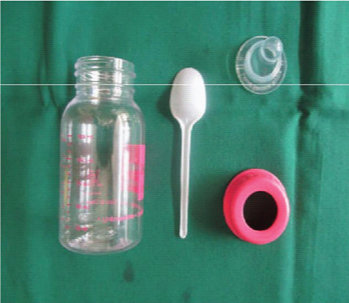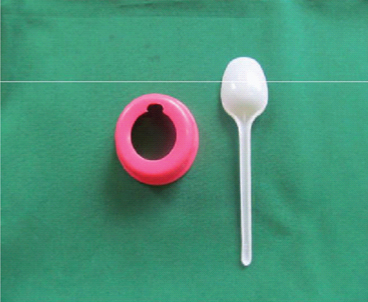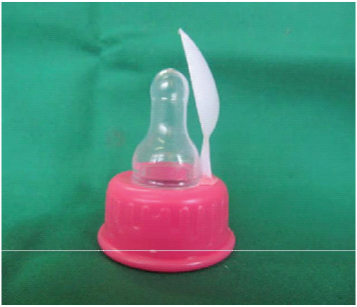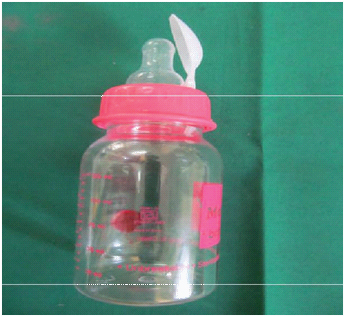A Innovative Technique - Modified Feeding Bottle for a Cleft Palate Infant
Vinuta Siddayya Hiremath1, Ashwini Budunur Lingegowda2, Sounyala Rayannavar3, Nirmala Kumari4
1 Lecturer, Department of Prosthodontics, KLE VK Institute of Dental Sciences, Belgaum, Karnataka, India.
2 Reader, Department of Prosthodontics, KLE VK institute of Dental Sciences, Belgaum, Karnataka, India.
3 Reader, Department of Prosthodontics, College of Dental Sciences, Davangere, Karnataka, India.
4 Lecturer, Department of Prosthodontics, College of Dental Sciences, Davangere, Karnataka, India.
NAME, ADDRESS, E-MAIL ID OF THE CORRESPONDING AUTHOR: Dr. Vinuta Hiremath, Lecturer, Department of Prosthodontics, KLE VK institute of Dental Sciences, Belgaum-590010, Karnataka, India.
E-mail: vinutaswamy@gmail.com
Cleft lip and cleft palate are one of the most common craniofacial anomalies. Infants suffer a lot of difficulty in sucking during the initial few days after birth. There is even psychological stress to the parents due to improper feeding and the infants lose weight and are prone to nutritional insufficiency. Due to recent advancement in the medical field, there is a total repair of cleft lip and cleft palate and these procedures are performed in the later stages of infants. It is the multidisciplinary approach which includes pedodontist, oral surgeon, prosthodontist and speech therapist. In this article, the technique is highlighted to fulfill the feeding problem of infants in the early stages of birth with a modified feeding bottle.
Introduction
Cleft lip and palate, are the most common congenital deformities of the orofacial region. Cleft palate is the split or opening in the floor of the mouth. During the growth of the fetus, different parts of the face develop separately and then fuse together. If there is any disturbance in the normal fusion, then there is cleft formation. Girls are affected most commonly by cleft palate without cleft lip than boys [1–3]. The cleft palate main problem is feeding, which is utmost essential in the early stages of the infants to provide better nutrition which is necessary for the growth and development [4,5]. But due to the separation of palatal area, there is the improper position of breast nipple for compression and no adequate negative intraoral pressure for suction on a bottle nipple which will result in insufficient feeding and nutrition [6,7].
In infants with cleft palate, surgery and orthodontist treatment comes in the later stages of life.so in this article modified feeding technique is used in the early stages of the infants to provide adequate nutrition through feeding.
Technique
1. A commercially available feeding bottle of 125ml is taken [Table/Fig-1].
Feeding bottle with screw threaded cap, spoon and nipple

2. A plastic flexible tablespoon of appropriate size is taken and extension of spoon in the palatal area is checked.
3. A trough is made in the screw threaded cap, neck part of the spoon handle is fitted completely [Table/Fig-2,3].
A trough made in the screw threaded cap

Neck part of the spoon handle is fitted completely

4. The fit of the spoon handle is checked and bowl part of the spoon should cover the cleft palate area without creating any gap between the palate and bowl back of spoon.
5. Once the fit is confirmed the neck part of the spoon handle is secured into the trough with the use of cyanoacrylate material.
6. The screw thread cap and nipple, spoon is assembled back into the body of the bottle and sterilized [Table/Fig-4].
The screw thread cap with nipple and spoon

Discussion
In the year 2014, the rate of incidence of cleft lip and palate is 1.5 per 1000 live births worldwide [1]. The main goal of managing cleft palate infants is maintaining a proper nutrition and a proper feeding technique for growth and development of infant and preparing the baby for corrective surgery. The infants feed through two methods by sucking that is drawing the milk and swallowing from oropharynx to stomach [2–5]. It is observed that babies use different techniques to suck the milk from a bottle and from the breasts. During regular breast feeding, infant uses tongue to suck the milk from a nipple by a negative pressure and in bottle feeding infant use gums and very offenly use tongue and palate to position the nipple and create sufficient negative pressure to suck the milk [4–6]. Cleft palate infant experience a difficulty in regular breastfeeding, because of improper seal of palates and sufficient sucking suction to pull the milk from a nipple and infant experience problems such as excessive air intake, nasal regurgitation, inadequate milk intake, weight lose, longer duration to feed due to improper feeding and proper guidance, support can lead to maternal stress, anxiety and poor mother and infant bonding [6–10]. A variety of artificial nipples with regular large base and long shaft, soft nipple with an enlarged outlet, large nipple base, compressible bottles and cup feeding are available [11–14]. In the article modified feeding bottle was constructed, it restores the oral and nasal separation during feeding and provide sufficient negative pressure, it prevented the entry of the tongue into the cleft, helps to maintain the nutrition, easy to construct and smooth surface without any irritation to palatal area. This modified feeding bottle has many advantages such as it can be customized, economical and easily accessible and is useful in the initial period of infant birth.
The most of the problems due to the cleft palate in neonate are solved by modified feeding bottle such as-
1. Helps to provide proper nutrition required in initial stages of infant development.
2. Helps in promoting neonatal weight gain which is required before corrective surgery.
3. Reduces the parental stress and anxiety.
Conclusion
Children with orofacial clefts often require early intervention and education in a co-ordinated manner throughout childhood and adolescence which helps to improve proper growth and development and helps to lead a healthy life.
[1]. Cleft lip and cleft palate. www.webmed.com/oral.health/guide/cleftlip-cleftpalate [Google Scholar]
[2]. Sree Devi E, Shankar AJ, Manoj MG, Sujatha B, Maiden Morsel –Feeding in cleft lip and palate infants J Int Soc Prevent Communit Dent 2012 2:31-37. [Google Scholar]
[3]. Ravichandra KS, Vijayaprasad KE, Vasa AAK, Susan S, A technique of impression making for an obturator in cleft lip and palate patient J Indian Soc Pedod Prev Dent 2010 28:311-14. [Google Scholar]
[4]. Osuji OO, Preparation of feeding obturators for infants with cleft lip and palate J Clin Pediatr Dent 1995 19:211-14. [Google Scholar]
[5]. Sterling K, Anderson B, Lynn S, feeding infants with cleft lip, cleft palate or cleft lip and palate Cleft Palate Journal 1987 24:244-49. [Google Scholar]
[6]. Saunders ID, Geary L, Fleming P, Gregg TA, A simplified feeding appliance for the infant with cleft lip and palate Quintessence Int 1989 20:907-10. [Google Scholar]
[7]. Julie Reid, A review of feeding interventions for infants with cleft palate Cleft Palate Craniofacial Journal 2004 41:268-78. [Google Scholar]
[8]. Gunay Y, Gurbuz B, Karayazgan B, Erkan M, Atay A, A preoperative appliance for a newborn with cleft palate Cleft Palate Craniofacial J 2009 46:53-57. [Google Scholar]
[9]. Narendra R, Sashi P, Sashi R, Simhachalam R, Feeding obturator –a presurgical prosthetic aid for infants with cleft lip and palate –Clinical report Annals and Essence of Dentistry 2013 5:1-5. [Google Scholar]
[10]. Lindberg N, Berglund AL, Mothers experiences of feeding babies born with cleft lip and palate Scand J Caring sci 2014 28(1):66-73. [Google Scholar]
[11]. Rathee M, Hooda A, Tamarkar AK, Yadav SPS, Role of feeding plate in cleft palate: case report and review of literature The Internet Journal of Otorhinolaryngology 2010 12(1) [Google Scholar]
[12]. Chandna P, Adlakha VK, Singh N, Feeding obturator appliance for an infant with cleft lip and palate Journal of Indian Society of Pedodontics and Preventive Dentistry 2011 29:71-73. [Google Scholar]
[13]. Jones JE, Henderson L, Avery DR, Use of a feeding obturator for infants with severe cleft lip and palate Spec Care Dentist 1982 2:116-20. [Google Scholar]
[14]. Oliver o osuji, Preparation of feeding obturators for infants with cleft lip and palate The Journal of Clinical Pediatric Dentistry 1995 19:211-14. [Google Scholar]